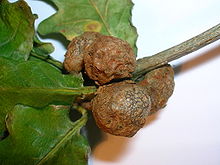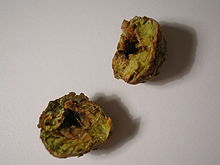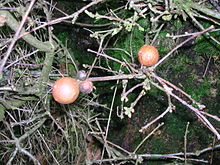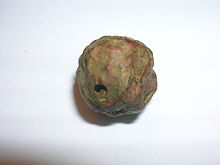- Andricus lignicola
-
Cola-nut gall Mature galls on pedunculate oak Scientific classification Kingdom: Animalia Phylum: Arthropoda Class: Insecta Order: Hymenoptera Family: Cynipidae Genus: Andricus Species: A. lignicola Binomial name Andricus lignicola
(Hartig, 1840)Cola-nut galls[1] develop as a chemically induced distortion of leaf axillary or terminal buds on Pedunculate Oak (Quercus robur) or Sessile Oak (Quercus petraea) trees, caused by the agamic gall wasp Andricus lignicola (Hartig, 1840) which lays single eggs within leaf buds using their ovipositor. A previous name or synonym for the species A. lignicola is A. lignicolus and A. venheurni.
Contents
The physical appearance of the galls
The galls are found in small groups, which however do not coalesce, helping to prevent mis-identification with the Oak marble gall (Andricus kollari), in addition the shape is ovoid rather than spherical and it is scaly rather than smooth. It grows up to about 10 x 8 mm and is at first green, rapidly changing to grey-brown, with light red patches where the original bud scales have separated. It is hard and firm, but does not always persist on the tree for very long.[2] Once the imago has emerged a small circular hole is apparent.[1]
Life-cycle
This gall is not thought to be native and was only recorded from 1972. It is well known in continental Europe, occurring from Holland to Asia Minor. The imago of the agamic phase emerges in early summer following the gall's inception. The bisexual generation gall is very similar to that of A. kollari, effecting the live bud of Quercus species[2] and has only been seen under culture conditions (1975).[3]
Gall-forming insects
 Pedunculate oak (Quercus robur) is a frequent host.
Pedunculate oak (Quercus robur) is a frequent host.
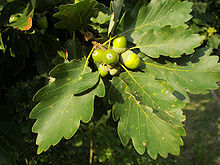 Sessile oak (Quercus petraea) is a frequent host.
Sessile oak (Quercus petraea) is a frequent host.
Some herbivorous insects therefore create their own micro-habitats by forming usually highly distinctive plant structures called galls, made up of plant tissue but controlled by the insect. Galls act as both the habitat, and food sources for the maker of the gall. The artichoke gall is formed from entirely from the bud, composed of nutritious starch and other tissues. Some galls act as "physiologic sinks", concentrating resources in the gall from the surrounding plant parts.[4] Galls may also provide the insect with physical protection from predators.[5]
Predators, inquilines and parasitoids
None seem to have been recorded in Britain as yet, supporting the recent spread theory of this gall to the United Kingdom.
Infestations of cola-nut galls
Removing and destroying cola-nut galls before they dry and the wasps emerge may help to reduce the infestation. While fairly large, and sometimes present in quite large numbers on scrub specimens, they cause no measurable harm.
See also
- Knopper gall
- Oak marble gall
- oak apple
- Rose bedeguar gall
- gall
- Gall wasp
- Pineapple gall
- Red-pea gall
References
- ^ a b Darlington, Arnold (1975) The Pocket Encyclopaedia of Plant Galls in Colour. Pub. Blandford Press. Poole. ISBN 0-7137-0748-8. P. 155.
- ^ a b Stubbs, F. B. Edit. (1986) Provisional Keys to British Plant Galls. Pub. Brit Plant Gall Soc. ISBN 0-9511582-0-1. P. 52.
- ^ Darlington, Arnold (1975) The Pocket Encyclopaedia of Plant Galls in Colour. Pub. Blandford Press. Poole. ISBN 0-7137-0748-8. p. 155.
- ^ Larson, K. C. & Whitham, T. G. (1991). "Manipulation of food resources by a gall-forming aphid: the physiology of sink-source interactions". Oecologia 88: 15–21. doi:10.1007/BF00328398.
- ^ Weis, A. E. & Kapelinski, A. (1994). "Variable selection on Eurosta’s gall size. II. A path analysis of the ecological factors behind selection". Evolution 48 (3): 734–745. doi:10.2307/2410482. JSTOR 2410482.
External links
- "Gall". Infoplease encyclopedia. http://www.infoplease.com/ce6/sci/A0820047.html. Retrieved March 2006.
Categories:- Cynipidae
- Oak galls
- Animals described in 1840
Wikimedia Foundation. 2010.

